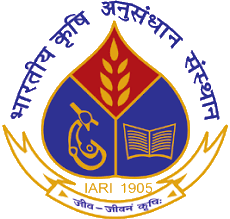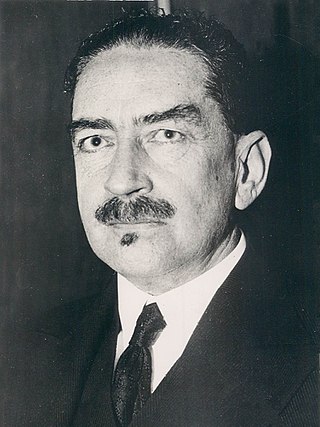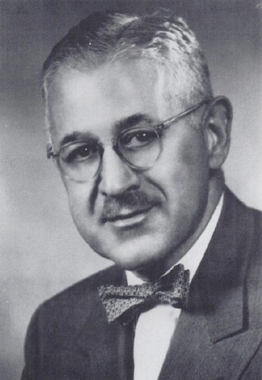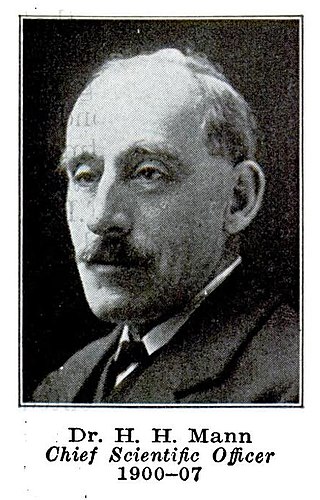Roland Victor Norris (1888 – 28 April 1950) was a biochemist and agricultural scientist who worked in India and Ceylon. [lower-alpha 1] He served as the first agricultural chemist to the government of Madras.
Roland Victor Norris (1888 – 28 April 1950) was a biochemist and agricultural scientist who worked in India and Ceylon. [lower-alpha 1] He served as the first agricultural chemist to the government of Madras.
Norris graduated from Manchester University and worked as an assistant to W.H. Perkin. He then worked at the Lister Institute of Preventive Medicine in London. In 1910 he worked with Professor Arthur Harden on yeast fermentation [1] [2] and received a D.Sc. from London University. In 1914 he took up the post of Physiological Chemist at the Imperial Bacteriological Laboratory in Mukteshwar, India. He served in the Indian Army briefly during the war and in 1918 he became the first Agricultural Chemist to the government of Madras. From 1924 to 1929 he worked as a professor of biochemistry at the Indian Institute of Science working on a range of agricultural problems including soil fertility, the chemistry of shellac and the spike disease of sandalwood. He moved to Ceylon [lower-alpha 1] in 1929 where he served as director of the Tea Research Institute. [3]
He was married to biochemist Dorothy Norris who later worked at the Lac research institute in Ranchi, Jharkhand, India. He was married secondly to Wendy Elizabeth Marie Quigley in 1934 and a daughter, Wendy Elizabeth Anne Jill, was born in Ceylon. [lower-alpha 1] [4] He visited South Africa in November 1949 and died in 1950 at Port Shepstone, South Africa. [5] He took a keen interest in sports, drama, and was a Freemason. [3]
Norris' work in England was mostly on glycogen metabolism and yeast fermentation. After moving to India, he worked on a range of topics including human nutrition, soil nutrients and microbiological processes.

Zymology, also known as zymurgy, is an applied science that studies the biochemical process of fermentation and its practical uses. Common topics include the selection of fermenting yeast and bacteria species and their use in brewing, wine making, fermenting milk, and the making of other fermented foods.

Eduard Buchner was a German chemist and zymologist, awarded the 1907 Nobel Prize in Chemistry for his work on fermentation.

The Indian Agricultural Research Institute (IARI), commonly known as the Pusa Institute, is India's national institute for agricultural research, education and extension. The name Pusa Institute is derived from the fact that the institute was originally located in Pusa, Bihar as the Imperial Institute of Agricultural Research in 1911. It was then renamed as the Imperial Agricultural Research Institute in 1919 and following a major earthquake in Pusa in 1934, it was relocated to Delhi in 1936. The current institute in Delhi is financed and administered by the Indian Council of Agricultural Research (ICAR). The IARI was responsible for the research leading to the "Green Revolution in India" of the 1970s. IARI ranked First among Agriculture and Allied Universities in the National Institutional Ranking Framework NIRF,

Hans Karl August Simon von Euler-Chelpin was a German-born Swedish biochemist. He won the Nobel Prize in Chemistry in 1929 with Arthur Harden for their investigations on the fermentation of sugar and enzymes. He was a professor of general and organic chemistry at Stockholm University (1906–1941) and the director of its Institute for organic-chemical research (1938–1948). Euler-Chelpin was distantly related to Leonhard Euler. He married chemist Astrid Cleve, the daughter of the Uppsala chemist Per Teodor Cleve. In 1970, their son Ulf von Euler, was awarded the Nobel Prize in Physiology or Medicine.

Sir Arthur Harden, FRS was a British biochemist. He shared the Nobel Prize in Chemistry in 1929 with Hans Karl August Simon von Euler-Chelpin for their investigations into the fermentation of sugar and fermentative enzymes. He was a founding member of the Biochemical Society and editor of its journal for 25 years.

Port Shepstone is a large town situated on the mouth of the Mzimkhulu River, the largest river on the KwaZulu-Natal South Coast of South Africa. It is located halfway between Hibberdene and Margate and is positioned 120 km south of Durban. It serves as the administrative, educational, industrial and commercial centre for southern Natal.
Zymase is an enzyme complex that catalyzes the fermentation of sugar into ethanol and carbon dioxide. It occurs naturally in yeasts. Zymase activity varies among yeast strains.

Oscar Loew was a German agricultural chemist, active in Germany, the United States, and Japan in the late 19th and early 20th centuries.

In food processing, fermentation is the conversion of carbohydrates to alcohol or organic acids using microorganisms—yeasts or bacteria—under anaerobic (oxygen-free) conditions. Fermentation usually implies that the action of microorganisms is desired. The science of fermentation is known as zymology or zymurgy.

William John Young was an English biochemist.

Major-General Sir Robert McCarrison, CIE, FRCP was a Northern Ireland physician and nutritionist in the Indian Medical Service, who was made a Companion of the Indian Empire (CIE) in 1923, received a knighthood in July 1933, and was appointed as Honourable Physician to the King in 1935.

Paul György (April 7, 1893 – March 1, 1976) was a Hungarian-born American biochemist, nutritionist, and pediatrician best known for his discovery of three B vitamins: riboflavin, B6, and biotin. Gyorgy was also well known for his research into the protective factors of human breast milk, particularly for his discoveries of Lactobacillus bifidus growth factor activity in human milk and its anti-staphylococcal properties. He was a recipient of the National Medal of Science in 1975 from President Gerald Ford.
Virander Singh Chauhan is an Indian scientist and a Rhodes Scholar working in the fields of genetic engineering and biotechnology. He is known for his contributions to the development of a recombinant vaccine for malaria. and for synthetic structural peptides with biological functions. He was honored by the Government of India in 2012 with the fourth highest Indian civilian award of Padma Shri. He is the present Chancellor of the Gandhi Institute of Technology and Management.

Jnanendra Nath Mukherjee CBE, FRSC was an Indian colloid chemist.
Leslie Denis Swindale was a New Zealand-born soil scientist, agriculturist, writer and a former chairman of the Department Agronomy and Soil Science of the University of Hawaii. He was the author of several books on soil and agricultural sciences and was a part of the Freedom from Hunger Campaign of the Food and Agriculture Organization. He was a Fellow of New Zealand Institute of Chemistry, American Society of Agronomy and a foreign fellow of the National Academy of Agricultural Sciences. The Government of India awarded him the third highest civilian honour of the Padma Bhushan, in 1991, for his contributions to science, making him one of the few non-Indians to receive the award.
Narinder Singh Randhawa (1927–1996) was an Indian agricultural scientist, writer and the director general of the Indian Council of Agricultural Research (ICAR). He was the president of the Indian Society of Soil Science during 1980–81 term and was a recipient of National Citizen Award and Rafi Ahmed Kidwai Award of the Indian Council of Agricultural Research. The Government of India awarded him the third highest civilian honour of the Padma Bhushan, in 1989, for his contributions to agricultural science.
Chirayathumadom Venkatachalier Subramanian, popularly known as CVS, was an Indian mycologist, taxonomist and plant pathologist, known for his work on the classification of Fungi imperfecti, a group of fungi classified separately due to lack of specific taxonomic characteristics. He authored one monograph, Hyphomycetes: An Account of Indian Species, Except Cercosporae and three books, Hyphomycetes, taxonomy and biology, Moulds, Mushrooms and Men and Soil microfungi of Israel, besides several articles published in peer-reviewed journals. He was a recipient of many honours including the Rafi Ahmed Kidwai Award of the Indian Council of Agricultural Research, the Janaki Ammal National Award of the Government of India and seven species of fungi have been named after him. The Council of Scientific and Industrial Research, the apex agency of the Government of India for scientific research, awarded him the Shanti Swarup Bhatnagar Prize for Science and Technology, one of the highest Indian science awards, in 1965, for his contributions to biological sciences.

Pasteur Institute of India, Coonoor is one of the pioneer institutes in India in the production of Anti Rabies Vaccine and DPT vaccine for the Expanded Programme of Immunization of Government of India. This institute started functioning as Pasteur Institute of Southern India, on 6 April 1907 and was officially opened by H. E. Sir Arthur Lawley, Governor of Madras, on 25 April 1907. The first President of the Society is Surgeon-General W.R. Browne, C.I.E., I.M.S., Surgeon-General with the Government of Madras. The first Honorary Secretary cum Director is Captain J.W. Cornwall, I.M.S., in his remembrance, the road starting from the adjacent area of main gate of the Pasteur Institute of India to Alwarpet named as Cornwall Road. The institute later renamed as Pasteur Institute of India and started functioning as an autonomous body under the Ministry of Health and Family Welfare, Government of India, from 10 February 1977. The affairs of the institute are managed by a governing body.

Harold Hart Mann was an English chemist, bacteriologist, and agricultural scientist who worked in India serving as principal of the College of Agriculture, Poona. He was a specialist on tea cultivation but later became a pioneer of sociological research.
Dorothy Norris née Harrop (?-?) was an English biochemist who worked on yeast fermentation, protein chemistry, and was a pioneer in the study of carcinogens. She moved to India where she worked at the Indian Institute of Science before becoming the founding director of the Indian Lac Research Institute at Ranchi.
South Africa, Natal Province, Civil Deaths, 1863-1955